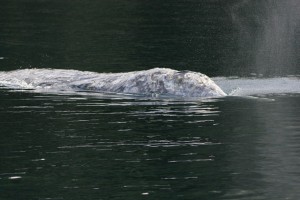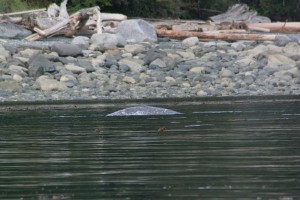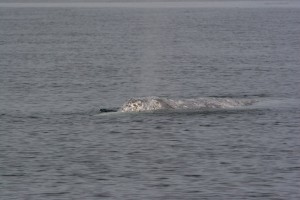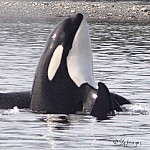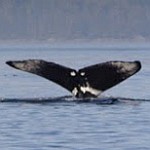Gray whales, or if you prefer spelling it Grey whales, have made a huge comeback from almost total extinction through commercial whaling. Estimated populations as low as a few hundred in the early 1900’s have rebounded to their pre-whaling populations of around 26,000 animals.
Gray whales roll on their side as they feed tight in close to shore scooping large mouthfuls of mud, sand and mucky bottoms which they filter through their baleen for amphipods and isopods (small crustaceans), worms and shrimp. They are seen in the Western most waters of BC enroute to their usually preferred summer feeding grounds of the Bering Sea. It has only been the last few years that these curious, and curious looking whales have been seen in the inside waters including the False Creek area of Vancouver, up the Howe Sound to Squamish, the Georgia Strait side of Sechelt, Campbell River and the Johnstone Strait areas. It appears they have decided to travel to their summer feeding grounds using our inner coast as well as the outside waters of BC; lucky us.
Although Gray whales have a predictable 16,000 kilometre round trip migration route from the coast of Baja, Mexico along the BC coast to the Bering Sea, these cetaceans are not the easiest to spot unless they have just spewed out or stirred up a large amount of mud leaving a visible trail. Known to take relatively long dives of five or more minutes, they can travel quite a distance from their last seen location. They have a low, billowing blow and do not usually show much of their bulky, tubular shaped body as they surface to breathe. Their lack of a dorsal fin and mottled grey appearance adds to the difficulty in spotting them especially when feeding close to shore. Once spotted though, it becomes evident how different, and almost prehistoric, these whales look as compared to other whales.
Eating from the mucky bottom of shallow bays has lead to concerns about the contaminants these animals are digesting. Although we have been cleaning up our coasts, the layers of contaminates below the surface layer in some of these bays are still of concern to the welfare of these and other marine animals.
Gray whale trivia:
The baleen on the Gray whale’s right side is usually worn down more than the left, indicating that they feed mainly “right-handed”. The whale in these photos was actually feeding mostly on its left side, but did alternate on occasion.
The Gray whale was called “devilfish” by whalers since the females fiercely protect their young and will put themselves in peril if necessary.
Frequently there are orange coloured spots on the Gray whale. These are whale lice.
Gray Whale – Eschrichtius robustus Facts:
Length:
up to 14 m (46 ft)
Weight:
up to 36,000 kg (77,000 lbs)
Colour:
Grey with whitish blotches
Features:
Robust, tube shaped, chunky body
Narrow, triangular head sloping downward to tip
Long downward curved mouth
Two small ventral pleats
Broad pectoral flippers
No dorsal fin
Low hump followed by small knobby ridges along back
